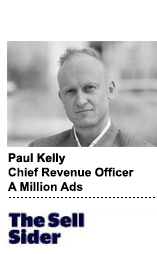“The Sell Sider” is a column written by the sell side of the digital media community.
Today’s column is written by Paul Kelly, CRO of A Million Ads.
Over half of all Americans have listened to a podcast. The venture capital and technology communities are taking note, funneling vast sums of money into the space. Why, then, are podcasts fundamentally under-monetized?
As an advertising vehicle, podcasts have yet to reach their full potential due to a limited array of advertising formats and a relatively small volume of inventory. Solving these problems will guarantee podcasting’s long-term sustainability and success.
Podcasting is expensive and tough to sustain
Bolstered by a flood of investment, podcasts have become incredibly ambitious. Production values have soared. This trend is especially evident when looking at the myriad of podcast-based audio dramas, with countless serialized shows touting A-list talent. Journalism has similarly embraced podcasting as a vehicle for sharing more in-depth news coverage.
For creators, the need to realize ROI is crucial to ensuring the sustainability of their work. Some shows can survive on user donations and subscriptions and, in many cases, thrive. (The top podcast on Patreon, True Crime Obsessed, earns between $139k and $364k each month.) Not everyone reaches these starry heights, however. Building a dedicated audience takes time and perseverance.
If the market for podcast advertising were more robust, creators and studios alike would be less reliant on subscriptions and other ancillary revenue models, such as merchandise and live events. Reaching that point will require the podcasting industry to rip up its playbook, adapt to this medium’s fundamental constraints and be prepared to pursue more ambitious means of monetization.
Ad tech is slowly disrupting podcasting
For advertising to take off in the space, podcasts have to capitalize on data. Typically delivered by RSS, podcasts reveal fewer metrics than other digital advertising formats for determining how many people ultimately listen to a show (and when they listen). There are no intelligent personalization engines for podcasts, which are asynchronous in nature. Content creators can readily access download numbers and their audience’s national and regional origins. Other vital demographic information, including consumer behaviors and interests, remains elusive.
What’s more, programmatic advertising is currently the exception, not the norm. Most podcast ads are bought, sold and delivered using an old-school mindset, with transactions conducted via lengthy email chains and Zoom calls.
The standard podcast is typically created using MP3 files, which limits advertisers’ creativity. While browser-based ads can adopt several innovative forms, like interactive quizzes, the inherently offline and asynchronous nature of podcasting makes this extremely challenging.
Fortunately, the industry is readily addressing these problems. Instreamatic, which raised $6.1 million last year, allows content creators to insert interactive, dialog-based voice ads into their podcasts. This technological innovation recognizes the diverse ways consumers are already listening to podcasts, with smart home assistants rapidly growing in popularity. Dialog-based advertising has the power to disrupt the current model and enhance performance for brands.
Audacy is home to some of the largest shows in the world, including “Pod Save America” and “Fly on the Wall.” Earlier this year, this network launched a platform that allows advertisers to tailor spending to the demographic and interest profiles of its shows. This increases the amount of inventory that is available programmatically, which improves efficiency, relevance and scalability. Spotify and iHeartMedia, both with sizable show portfolios, are similarly able to take advantage of ad placement based on affinity and interests.
Also notable is iHeartMedia’s partnership with Sounder, which provides brand safety intelligence for prospective advertisers. Sounder’s technology automatically transcribes podcasts and, using its own machine learning technology, can identify potential brand safety concerns within the content. As podcast creators increasingly rely on ads to monetize their content, this technology is certain to become widespread.
Building a path for further personalization
The lessons learned from podcasting will help the digital advertising industry meet other looming challenges, most notably the ever-shrinking well of data for personalization. With browser cookies set to be retired by next year, and app-based tracking becoming ever more difficult, podcasting can provide a welcome vehicle for digital advertisers to thrive in a post-profiling world.
Follow A Million Ads (@amillionads) and AdExchanger (@adexchanger) on Twitter.














